Ditapis dengan
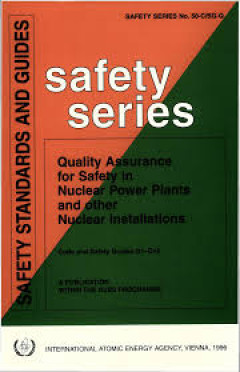
Quality Assurance for Safety in Nuclear Power Plants and Other Nuclear Instal…
The revised Safety Code and its corresponding Safety Guides replace Safety Series No. 50-C-QA (Rev. 1), Code on the Safety of Nuclear Power Plants: Quality Assurance, and Safety Series Nos 50-SG-QA1 to 50-SG-QA11, and present new simplified basic requirements and implementation methods for quality assurance in a nuclear context. They provide recommendations to regulatory bodies in establishing …
- Edisi
- -
- ISBN/ISSN
- 9201036965 / 00741892
- Deskripsi Fisik
- 356 p. : Illus. ; 24 cm
- Judul Seri
- Safety Series No. 50-C/SG-Q
- No. Panggil
- 621.483 IAE Q

Radiation Protection against Radon in Workplaces other than Mines | Safety Re…
This report deals with radon and thoron and their decay products in workplaces other than mines. It is intended for use in the application of radiation protection principles in those workplaces where employers may not have an extensive background in radiation protection. It provides practical information on action levels for workplaces, on monitoring techniques and on actions aimed at reducing …
- Edisi
- 33
- ISBN/ISSN
- 92–0–113903–9 / 1020–6450 ; no. 33
- Deskripsi Fisik
- 79 p;57KB
- Judul Seri
- -
- No. Panggil
- 613.62 IAE R

Procedures for Conducting Probabilistic Safety Assessments of Nuclear Power P…
This safety practice report provides guidance on conducting a Level 1 PSA for internal events in nuclear power plants. The main emphasis is on the procedural steps of the PSA rather than the details of the corresponding methods. The report is intended to assist technical persons managing or performing PSAs. A particular aim is to promote a standardized framework, terminology and form of documen…
- Edisi
- -
- ISBN/ISSN
- 9201023928 / 00741892
- Deskripsi Fisik
- 175 p. : Illus. ; 24 cm
- Judul Seri
- Safety Series No. 50-P-4
- No. Panggil
- 621.48 IAE p
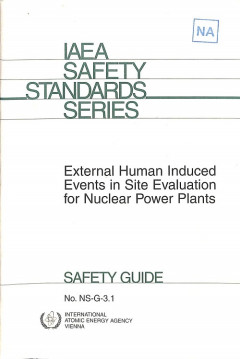
External Human Induced Events in Site Evaluation for Nuclear Power Plants | I…
This Safety Guide recommends actions, conditions and procedures in relation to external human induced events and provides guidance for fulfilling the requirements of Safety Standards Series No. NS-R-3, Site Evaluation for Nuclear Installations, when conducting a site evaluation for a nuclear power plant.
- Edisi
- -
- ISBN/ISSN
- 9201112025 / 1020525X
- Deskripsi Fisik
- 49 p. : Illus. ; 24 cm
- Judul Seri
- Safety Standards Series No. NS-G-3.1
- No. Panggil
- 621.483
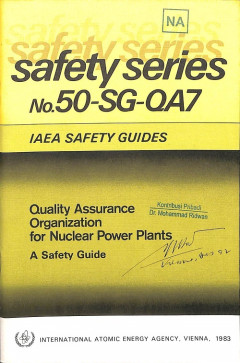
Quality Assurance Organization for Nuclear Power Plants, A Safety Guide | Saf…
This book consist : Introduction; Basic principles for structuring, staffing and documenting the organization for quality assurance; Organizational structure of the responsible organization; Organization of the plant disgners; Organization of manufacturers and constructors; and Record. (Jml)
- Edisi
- -
- ISBN/ISSN
- 9201231830
- Deskripsi Fisik
- 52 p. : Illus. ; 24 cm
- Judul Seri
- Safety Series No. 50-SG-QA7
- No. Panggil
- 621.483 IAE S
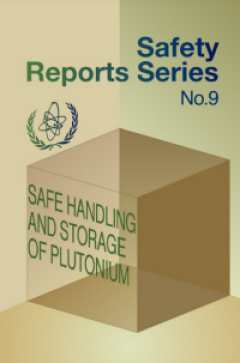
Safe Handling and Storage of Plutonium | Safety Reports Series No. 9
This Safety Report updates IAEA Safety Series No. 39, Safe Handling of Plutonium (1974), and provides an overview of modern practices for handling and storing separated plutonium. It provides descriptions of plutonium and its properties, and of the biological effects on humans of plutonium. The principles underlying the safe design and operation of plutonium handling/storage facilities and the …
- Edisi
- 9
- ISBN/ISSN
- 92–0–102998–5 / 1020–6450 ; no. 9
- Deskripsi Fisik
- 147 p ; 545KB
- Judul Seri
- -
- No. Panggil
- 546.434 IAE S
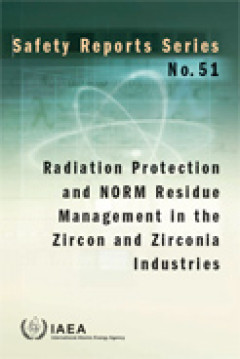
Radiation Protection and NORM Residue Management in the Zircon and Zirconia I…
Zircon has economic importance as a raw material in its own right and also as a feedstock for the manufacture of zirconia (zirconium dioxide), zirconium chemicals and zirconium metal. The geological processes that formed zircon led to the incorporation of radionuclides of natural origin into the crystal structure. The presence of these radionuclides is not significant enough to be of any commer…
- Edisi
- 51
- ISBN/ISSN
- 92–0–100607–1 / 1020–6450 ; no. 51
- Deskripsi Fisik
- 162 p; 1.82MB
- Judul Seri
- -
- No. Panggil
- 614.839 IAE R
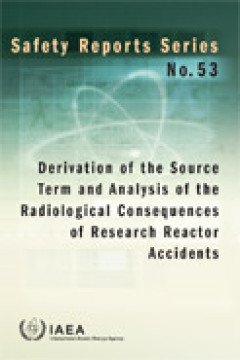
Derivation of the Source Term and Analysis of the Radiological Consequences o…
This report provides a set of suggested methods and practices for determining the source term and analysing the radiological consequences of research reactor accidents. It provides safety analysts, regulators, and reactor facility management and operations staff, with the calculation methods and techniques necessary for deriving the source term. This includes all factors relevant to the formati…
- Edisi
- 53
- ISBN/ISSN
- 978–92–0–109707–1 / 1020–6450 ; no. 53
- Deskripsi Fisik
- 193 p; 2.84MB
- Judul Seri
- -
- No. Panggil
- 616.9897 IAE D
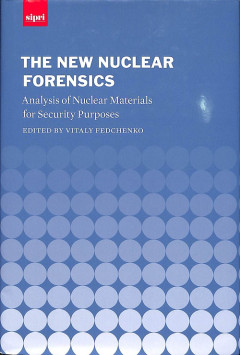
The New Nuclear Forensics: Analysis of Nuclear Materials for Security Purposes
This book is about nuclear forensics. The development of nuclear technology is so advanced for the world of health, agriculture, mining industry, and others. However, on the other hand, nuclear is often misused, for example in terrorism, smuggling of nuclear materials, radioactive substances. Therefore, it is necessary to control and forensic studies to analyze what has happened. This book disc…
- Edisi
- -
- ISBN/ISSN
- 9780198736646
- Deskripsi Fisik
- 279 p. : illus. ; 24,5 cm
- Judul Seri
- -
- No. Panggil
- 303 FED n
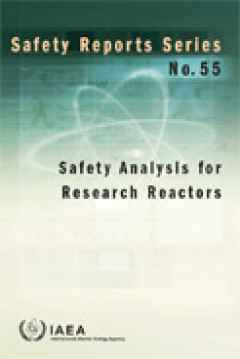
Safety Analysis for Research Reactors | Safety Reports Series No. 55
This publication provides practical guidance for performing safety analyses of research reactors. The guidance is based on present good practice worldwide. It covers all the steps required to perform safety analyses, i.e. selection of initiating events and acceptance criteria, rules and conventions, selection of computational tools, and presentation and evaluation of the analysis results. The s…
- Edisi
- -
- ISBN/ISSN
- 978-92-0-101008-7
- Deskripsi Fisik
- 81 p;1.41 MB
- Judul Seri
- -
- No. Panggil
- 621.483 IAE S
 Karya Umum
Karya Umum  Filsafat
Filsafat  Agama
Agama  Ilmu-ilmu Sosial
Ilmu-ilmu Sosial  Bahasa
Bahasa  Ilmu-ilmu Murni
Ilmu-ilmu Murni  Ilmu-ilmu Terapan
Ilmu-ilmu Terapan  Kesenian, Hiburan, dan Olahraga
Kesenian, Hiburan, dan Olahraga  Kesusastraan
Kesusastraan  Geografi dan Sejarah
Geografi dan Sejarah